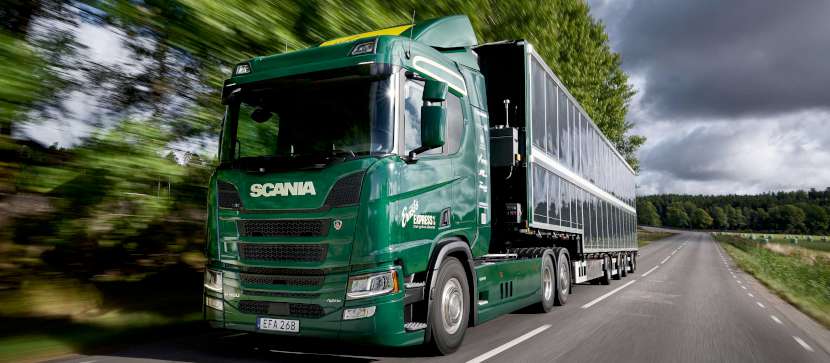This looks like a great idea. The surface area of a semi trailer is similar to that of a reasonable sized house. Cover this in lightweight solar panels and you have a power source for the truck. If the power generated were sufficient, a truck driving around in a sunny country would never need to stop to refuel or recharge.
That’s a big if at this stage.
Scania’s unique hybrid truck with a solar panel covered trailer is currently being tested on public roads, as a result of a two-year research collaboration involving Scania, Uppsala University, Eksjö Maskin & Truck, Midsummer, Ernsts Express, and Dalakraft.
“Scania’s purpose is to drive the shift towards a sustainable transport system. Never before have solar panels been used to generate energy to a truck’s powertrain like we do in this collaboration. This natural energy source can significantly decrease emissions in the transport sector. It is great to be at the forefront in the development of the next generation’s trucks,” says Stas Krupenia, Head of the Research Office at Scania.
New, Lightweight Solar Panels
The truck is used in a research project to examine the generated solar energy, and how much carbon emissions decrease via the solar panels. The researchers developed new, efficient, and lightweight solar panels for trucks.
“This is an exciting project where academia and industry together try to decrease the climate impact from truck transports. The results from this unique truck will be very interesting,” says Erik Johansson, Project Manager and Professor of physical chemistry at Uppsala University.
The Up- and Downsides
Despite the truck’s 18-metre trailer being almost completely covered in solar panels, equivalent to a house equipped with similarly powerful panels, the solar energy generated is just 8,000kWh in a country like Sweden. In countries like Spain, with more sun hours, the vehicle can double the amount of solar energy and thus driving range compared to Swedish circumstances.
Looking at UK electricity costs of about 30 pence per kWh, the saving on electricity is around £2,500 a year – although this could be as much as £5,000 a year in sunnier climes. Scania has provided no costs for the trailer installation, but the payback for the system will be counted in decades, not years. Consider also the likelihood of damage to the panels and the impact of the loss in payload the panels will create.
A battery tractor unit will need well over 400kWh per day to operate and with these panels producing 20 to 40 kWh per day they will only scratch the surface of the truck’s electrical needs. There is some light on the horizon, however, the project also includes researched on new, lightweight tandem solar cells, that are based on a combination of Midsummer’s solar cells and new perovskite solar cells. These enable a higher efficiency in the transformation of sunlight to electricity. Such a solution could double the solar energy generation, compared to the current energy generated by the panels.
“Our research towards efficient and light solar cells will be truly important, especially when it comes to applying them in future trucks,” Johansson continues.
“Our solar panels are excellent for applications that make commercial vehicles sustainable. We see great potential to decrease the emissions from heavy vehicles with electrification. Electricity generated by solar panels will save fuel and carbon emissions. We want to be a partner to count on, and that is enabled by this ground-breaking project,” says Erik Olsson, Head of Corporate Development, Midsummer.
Daniel Sandh, CEO Eksjö Maskin & Truck, agrees: “The fuel is presently an increasing cost for haulage companies, and everything we can contribute with to lower this cost will benefit the society long-term.”
One part of the project was to evaluate the charging’s impact on the electricity grid and whether it would be possible to sell the surplus. The possibility of two-way charging is not entirely straightforward and the legislation is unclear.
“We thought we would be able to buy the trucks surplus, unfortunately that is not possible at the moment. But the solar cells becoming part of the truck’s energy supply is fantastic. As an electricity trading company, we see that all renewable energy sources are needed to cope with the energy transition,” says Sverker Ericsson, Electrical Trade Engineer at Dalakraft.

560 horsepower plug-in hybrid with 100 sqm of solar panels.
The truck will now be tested by operating on public roads by the haulage company Ernsts Express AB. “The whole industry is facing big challenges in general, and with fuel in particular. Electrification from renewable electricity is the future. It makes this project even greater for the green haulage company to be a part of,” says Lars Evertsson, CEO Ernsts Express.
The truck is a 560 horsepower plug-in hybrid. On the 18-metre trailer, an area of 100 square meters is covered by thin, lightweight and flexible solar panels with a maximum efficiency of 13,2 kWp (kilowatt peak). They are estimated to deliver 8,000 kilowatt hour (kWh) annually when operated in Sweden. The batteries have a total capacity of 300 kWh, with 100 kWh on the truck and 200 kWh on the trailer.
